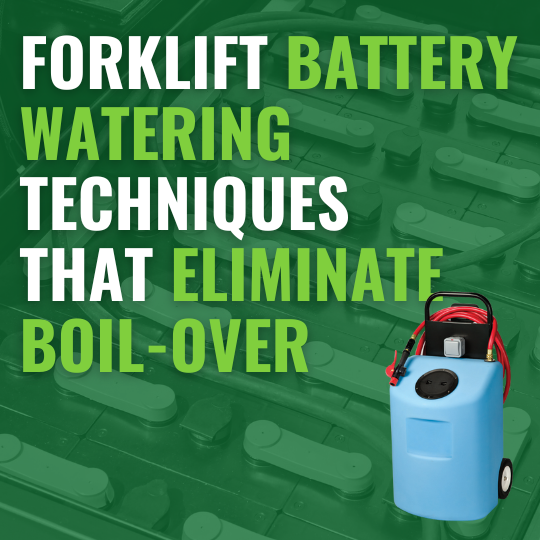We use cookies to make your experience better. To comply with the new e-Privacy directive, we need to ask for your consent to set the cookies. Learn more.
Forklift Battery Watering Techniques That Eliminate Boil-Over
If there’s one thing that drives battery room operators crazy, it’s batteries boiling over. This hazard is so frustrating for a simple reason: boil-overs are completely preventable. Batteries boil over when too much water is added to a cell. To eliminate the problem once and for all, follow a few simple guidelines — and make sure staff is trained to watch electrolyte levels during watering.
A Little Background: What Causes Forklift Batteries To Boil Over?
Battery electrolyte heats up during a charge. When substances get hotter — especially large volumes of sulfuric acid mixed with water — they expand. If staff doesn't leave room for that expansion within the battery cell, you know what happens: boil-over during the next charge.
Electrolyte spillage is an even bigger problem than it first appears, and it’s definitely no fun to clean up a battery spill. When a battery boils over, it flings sulfuric acid nearly everywhere that you don't want it to be: onto battery cases, floors, racks, and maybe even lift trucks themselves. If employees happen to be nearby during a boil-over, they may be exposed to hazardous sulfuric acid as well.
Here’s the worst part — boil-overs literally spill the life out of your batteries. Every time a battery boils over, cells lose sulfates. Industry experts estimate that batteries lose three to five percent of their total capacity with every boil-over. Over time, that lost capacity adds up, and battery run-time diminishes rapidly.
Adding Water to Forklift Battery Electrolyte by Hand
Certainly, automated, single-point watering systems are ideal — but most facilities don’t have such a device in place. Industry publication Modern Materials Handling reports that 70% of forklift batteries are filled by hand in the United States.
Most often, the person doing the hand-filling of the forklift battery is the operator of the forklift. Make sure your lift truck operators are adequately trained to handle battery watering tasks. Hand-filling a battery is dangerous, with high risk of spillage. Even worse, staff may resort to dangerous positions in order to reach battery cells deep in racks, or within a forklift battery compartment.
Give your staff the best possible access with a powered, portable watering cart and a dedicated watering gun. Watering guns extend reach and provide a simple angle for filling cells. Plus, they control the water flow to ensure that cells are never overfilled.
If your facility doesn’t have adequate AC or DC power supplies where you add water to battery cells, that’s no problem. A 10-gallon Bladder Tank from Solus Group allows staff to water batteries without the need for electrical power.
Keep Your Battery Room Operator Happy
Most battery manufacturers recommend watering cells only after an equalizing charge to prevent overfilling. Facilities that use their batteries heavily should water batteries about once a week. Also, staff should always have full access to the top of the battery; don’t make them stretch or climb stands to reach every cell.
These guidelines — along with the right equipment — will help employees keep battery electrolyte within optimal limits, preventing boil-overs and other headaches. When you reduce the threat of boil-over, battery room operators will breathe a sigh of relief.
References:
Bond, Josh. “Improving safety in lift truck battery maintenance.” Logisticsmgmt. Peerless Media LLC, 2 Oct. 2012. Web. 27 Feb. 2016.
Gooley, Toby. “Battery Room Confidential.” DCVelocity. Agile Business Media, LLC, 22 July 2013. Web. 27 Feb. 2016.
Vanasse, Harold. “Other Voices: Lean thinking in the industrial battery room.” Logisticsmgmt. Peerless Media LLC, 17 Sep. 2014. Web. 27 Feb. 2016.
Vanasse, Harold. “Other Voices: The major impact of watering on battery room operations and maintenance.” MMH. Peerless Media LLC, 10 Sept. 2015. Web. 27 Feb. 2016.

